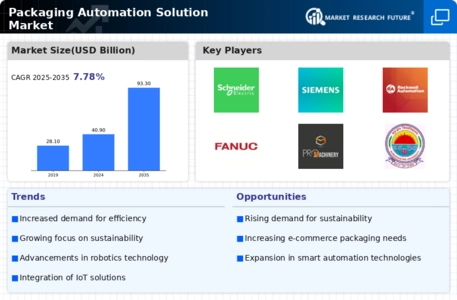Focus on Sustainability
Sustainability has emerged as a critical driver within the Packaging Automation Solution Market. Companies are increasingly prioritizing eco-friendly packaging solutions to meet regulatory requirements and consumer preferences. The shift towards sustainable practices is not merely a trend; it reflects a broader commitment to environmental responsibility. Many organizations are investing in automated packaging systems that utilize recyclable materials and reduce waste. Data suggests that nearly 70% of consumers are willing to pay more for sustainable products, which further incentivizes companies to adopt green packaging solutions. As sustainability becomes a core business strategy, the Packaging Automation Solution Market is expected to expand significantly.
Technological Advancements
Technological advancements play a pivotal role in shaping the Packaging Automation Solution Market. Innovations such as artificial intelligence, machine learning, and the Internet of Things are revolutionizing packaging processes. These technologies enable real-time monitoring and predictive maintenance, which can minimize downtime and enhance overall system reliability. For instance, AI-driven systems can optimize packaging lines by analyzing data and adjusting operations accordingly. The integration of these advanced technologies is expected to drive market growth, with projections indicating a compound annual growth rate of over 10% in the coming years. As manufacturers increasingly adopt these cutting-edge solutions, the Packaging Automation Solution Market is likely to witness transformative changes.
Rising Demand for Efficiency
The Packaging Automation Solution Market experiences a notable surge in demand for efficiency across various sectors. Companies are increasingly seeking to streamline their operations, reduce labor costs, and enhance productivity. Automation solutions facilitate faster packaging processes, which can lead to significant time savings. According to recent data, businesses that implement automation can achieve up to a 30% increase in operational efficiency. This trend is particularly evident in industries such as food and beverage, pharmaceuticals, and consumer goods, where the need for rapid packaging solutions is paramount. As companies strive to meet consumer expectations for quick delivery and high-quality products, the Packaging Automation Solution Market is poised for substantial growth.
Customization and Personalization
Customization and personalization are becoming essential components of the Packaging Automation Solution Market. As consumer preferences evolve, businesses are increasingly required to offer tailored packaging solutions that cater to individual needs. Automation technologies enable manufacturers to produce smaller batch sizes and unique designs without sacrificing efficiency. This flexibility allows companies to respond swiftly to market trends and consumer demands. Recent studies indicate that brands that offer personalized packaging can enhance customer engagement and loyalty, leading to increased sales. Consequently, the Packaging Automation Solution Market is likely to see a rise in demand for solutions that facilitate customization.
Regulatory Compliance and Safety Standards
Regulatory compliance and safety standards are significant drivers in the Packaging Automation Solution Market. As governments and regulatory bodies impose stricter guidelines on packaging materials and processes, companies must adapt to remain compliant. Automation solutions can assist in ensuring that packaging meets safety and quality standards, thereby reducing the risk of costly recalls and legal issues. The need for compliance is particularly pronounced in industries such as pharmaceuticals and food and beverage, where safety is paramount. As organizations strive to adhere to these regulations, the Packaging Automation Solution Market is expected to grow, driven by the demand for reliable and compliant packaging solutions.

















Leave a Comment